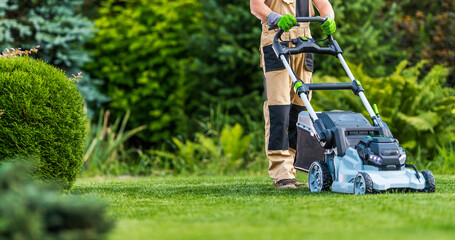
A lush, green lawn not only boosts curb appeal but also creates a welcoming outdoor space for relaxation and activities. Lawn care, however, requires consistent attention, the right techniques, and proper seasonal adjustments. By understanding the essentials of lawn maintenance, anyone can achieve a vibrant yard that remains healthy throughout the year.
Why Lawn Care Matters
Maintaining a well-kept lawn goes beyond just looks. Healthy grass improves air quality, reduces soil erosion, and provides a natural cooling effect during hot weather. A properly maintained lawn also prevents weed growth, discourages pests, and enhances the overall value of a property.
Good lawn care practices ensure that grass grows thick, strong, and resistant to common issues such as disease, drought, and foot traffic damage.
Mowing the Right Way
One of the most basic yet important aspects of lawn care is mowing. Cutting the grass too short may seem convenient, but it can stress the lawn and leave it vulnerable to weeds and disease. The general rule is to mow frequently enough to maintain an even height without removing more than one-third of the blade at a time.
Keeping mower blades sharp is also essential. Dull blades tear the grass, causing jagged edges that dry out and turn brown. Regularly maintaining mowing equipment ensures clean cuts and a healthier lawn.
Watering for Optimal Growth
Proper watering is a cornerstone of lawn care. Overwatering can lead to shallow root growth and fungal issues, while underwatering causes grass to turn brown and brittle. The best practice is deep, infrequent watering that allows moisture to penetrate the soil and encourages strong roots.
Morning watering is ideal because it gives the lawn time to dry during the day, reducing the risk of disease. A well-hydrated lawn is more resilient against heat, drought, and daily use.
Fertilizing for Strong Roots and Growth
Fertilization provides essential nutrients that grass needs to thrive. Nitrogen, phosphorus, and potassium are the primary components of lawn fertilizers, each serving a specific purpose in growth, root development, and overall health.
Applying fertilizer at the right times of the year is key. Seasonal feeding supports growth cycles and helps the lawn withstand environmental stress. Over-fertilization, however, can harm the grass and contribute to thatch buildup, so balanced application is important.
Aeration for Healthy Soil
Over time, soil becomes compacted from foot traffic and natural settling. Compacted soil makes it difficult for water, nutrients, and oxygen to reach the roots. Lawn aeration is the process of creating small holes in the soil to relieve compaction and improve airflow.
This step is particularly beneficial in high-traffic areas of the yard. Aeration not only strengthens root systems but also enhances overall lawn resilience.
Weed Control and Prevention
Weeds are one of the most common challenges in lawn care. They compete with grass for sunlight, water, and nutrients, often leaving unsightly patches. Preventing weeds is easier than removing them, which is why consistent lawn maintenance is essential.
A thick, healthy lawn is the best defense against weeds. Proper mowing, watering, and fertilization create conditions where grass outcompetes unwanted plants. For stubborn weeds, targeted treatments may be necessary, but prevention should always be the priority.
Pest and Disease Management
Pests and lawn diseases can quickly damage even the healthiest yards. Common signs include brown patches, chewed blades, or unusual spots on the grass. Identifying the problem early makes management easier and prevents long-term damage.
Integrated lawn care practices such as proper watering, aeration, and balanced fertilization help reduce the risk of infestations. A strong, healthy lawn is naturally more resistant to pests and disease.
Seasonal Lawn Care Adjustments
Lawn care is not a one-size-fits-all routine. Each season brings unique challenges that require specific attention.
- Spring: Focus on cleaning debris, aerating soil, and applying the first round of fertilizer to kickstart growth.
- Summer: Prioritize proper watering and mowing while monitoring for weeds and pests. Avoid heavy fertilization during extreme heat.
- Fall: Aerate, fertilize, and overseed to strengthen the lawn before winter. Fall preparation sets the stage for lush growth in the following spring.
- Winter: Limit foot traffic, keep the yard clear of heavy debris, and prepare equipment for the upcoming season.
Adjusting lawn care routines based on seasonal needs ensures long-term success and consistent greenery.
The Role of Soil Health
Healthy soil is the foundation of any thriving lawn. Conducting a soil test helps determine nutrient levels, pH balance, and specific requirements for optimal growth. Based on the results, appropriate amendments such as lime or organic matter can be added.
When soil health is prioritized, grass becomes more resilient, requiring less intervention in the long run.
Lawn Care Tools and Equipment
The right tools make lawn care more efficient and effective. A reliable mower, trimmer, rake, and watering system are essentials. For more advanced care, aerators, dethatchers, and spreaders can significantly improve results.
Regular maintenance of equipment ensures durability and better performance, reducing the time and effort needed for lawn upkeep.
Eco-Friendly Lawn Care Practices
Sustainable lawn care is becoming increasingly important. Using organic fertilizers, conserving water, and recycling grass clippings as natural mulch all contribute to an eco-friendly approach. These practices reduce environmental impact while keeping the lawn healthy and vibrant.
Incorporating native grasses and plants can also minimize maintenance needs and promote biodiversity in the yard.
Lawn care is more than just a chore—it’s an investment in creating a healthy, inviting, and beautiful outdoor space. From mowing and watering to fertilization and seasonal adjustments, each step plays an essential role in achieving lasting results. By focusing on soil health, proper maintenance, and eco-friendly practices, anyone can enjoy a greener, more resilient lawn throughout the year.